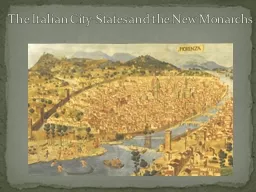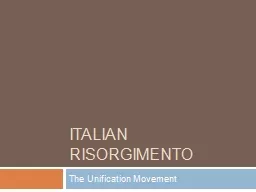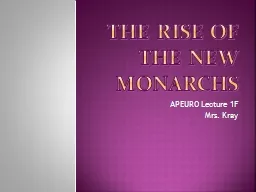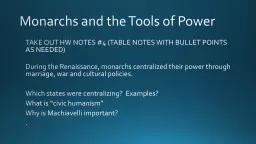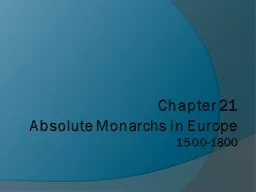PPT-The Italian City-States and the New Monarchs
Author : jewelupper | Published Date : 2020-07-03
The Italian CityStates and the New Moncarchs Why did the Renaissance begin in northern Italy Geography is destiny The Italian CityStates and the New Moncarchs
Presentation Embed Code
Download Presentation
Download Presentation The PPT/PDF document "The Italian City-States and the New Mona..." is the property of its rightful owner. Permission is granted to download and print the materials on this website for personal, non-commercial use only, and to display it on your personal computer provided you do not modify the materials and that you retain all copyright notices contained in the materials. By downloading content from our website, you accept the terms of this agreement.
The Italian City-States and the New Monarchs: Transcript
The Italian CityStates and the New Moncarchs Why did the Renaissance begin in northern Italy Geography is destiny The Italian CityStates and the New Moncarchs Why did the Renaissance begin in northern Italy. Tempo & Dynamics. TEMPO. DYNAMICS. TEMPO. Tempo words describe . SPEED. .. . . Italian. . Meaning. Slow. Lento Slow. Largo Slow and stately. Adagio Leisurely. Andante At a walking pace. Past and Present. Architecture. Roman architectural idioms of arches, columns and domes - foundations of later Italian architecture. The Romanesque style (9th to 11th century). The Renaissance style (the late 14th to the 16th c). “Revival” and The Unification Movement . The Legacy of France . Napoleon . Invaded Italy and added much of Italy to the French Empire . Established puppet governments. Structure of French . govt. The Italian Society: Past and Present. The Paradoxes of the Italian Society. “In Italy for thirty years under the . Borgias. they had warfare, terror, murder and bloodshed but they produced Michelangelo, Leonardo . By Andrew Knowlton and . Jack Anderson. Absolutism. Absolutism was a response to the religious wars, plagues, and destruction that plagued Europe.. Rulers who came to power were paranoid of losing it. The Italian Society: Past and Present. The Paradoxes of the Italian Society. “In Italy for thirty years under the . Borgias. they had warfare, terror, murder and bloodshed but they produced Michelangelo, Leonardo da Vinci and the Renaissance. In Switzerland, they had brotherly love, they had five hundred years of democracy and peace and what did that produce? The Cuckoo clock.” Orson Welles in . APEURO Lecture 1F. Mrs. . Kray. Niccolo. Machiavelli’s . The Prince, 1513. Manual for a realistic ruler. Considered first work of political science. Some say “The Prince” was Ferdinand of Aragon. 330–1450. ). . Lesson 5 . The Feudal Monarchs and the Church. . Learning Objectives. Learn how monarchs gained power over nobles and the Christian Church, and how English kings strengthened their power.. Case Study #2. Italian Expansion, 1870-1933. Italy in 1815. What appears to be the state of Italy in 1815 according to the map?. Italian Unification. Occurs in 1861 (efforts of Cavour and Garibaldi). During the Renaissance, monarchs centralized their power through marriage, war and cultural policies. .. Questions about HW?. .. Power in the Renaissance – Monarchs and Machiavelli. A MISCONCEPTION: . French Absolutism, Enlightenment, & Revolution Outcome: Absolutism & Absolute Monarchs Constructive Response Questions Summarize what an absolute monarch is and provide at least two concrete examples. Chapter 21 Absolute Monarchs in Europe 1500-1800 Section 1 Spain’s Empire and European Absolutism pg. 589 - 595 Introduction to Absolutism Spain’s Powerful Empire Philip II comes to power in Spain Chamber of Commerce, City Economic Development Dept. CNM, City Municipal Dept. (DMD), City Environment Dept., City Solid Waste Dept., City Fire Dept., United Way of Central New Mexico Albuquerque Progress Report: Roko Italian Cuisine is a family owned and operated Italian restaurant located in Mayfaire Town Center Wilmington NC The restaurant is open nightly from 4pm-11pm For more information about Roko Italia
Download Document
Here is the link to download the presentation.
"The Italian City-States and the New Monarchs"The content belongs to its owner. You may download and print it for personal use, without modification, and keep all copyright notices. By downloading, you agree to these terms.
Related Documents

